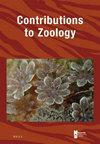爪子的欺骗性保守性:分子和形态学证据揭示了隐藏在异足目(真足目)中的不同的系统谱系
IF 2.2
2区 生物学
Q1 ZOOLOGY
引用次数: 44
摘要
同形生物很可能是半缓步动物最基本的分支进化谱系。尽管是第二大的半动物目,但这一群体的系统发育关系和系统分类学仍未得到很大的解决。广泛的分类群取样,特别是在物种最多的缓步动物之一isohypibiusthulin, 1928,以及比较形态学方法(光对比和扫描电子显微镜成像的外部形态和口腔器官)和系统发育框架(18S + 28S rRNA序列)的应用,导致了迄今为止对该目最全面的研究。从目前公认的isohypibiidae家族中建立了两个新的家族:Doryphoribiidae fam。11月,包括所有水生等异形和一些具有腹侧板的陆生等异形类群;和盐生物潮科。11月,对海洋环境有独特适应的次生海洋半水栖动物。为了适应系统发育、形态学和生态学上的差异,我们还将其分为4个属:陆生的Isohypsibius s.s. (Isohypsibiidae),具有光滑或雕刻的角质层,但没有赘肉;陆生狄安属11 .(同棘蝇科),具小而尖的突起;陆生乌尔苏尼乌斯属,长有大而圆的赘肉;水生绿蝇(Doryphoribiidae)。11月),典型地具有粗糙的角质层和爪,分枝高度非常相似。爪形态进行了审查,并首次显示,包括一些形态型,相关的分支在分子分析中恢复。咽部和角质层的解剖结构也被证明是区分等假说生物总群中超种分类群的重要依据。讨论了所有异拟生物科和属的分类,特别强调了新建立的实体。最后,提供了所有目前公认的异拟生物家族和属的畸形诊断关键。本文章由计算机程序翻译,如有差异,请以英文原文为准。
Deceptive conservatism of claws: distinct phyletic lineages concealed within Isohypsibioidea (Eutardigrada) revealed by molecular and morphological evidence
Isohypsibioidea are most likely the most basally branching evolutionary lineage of eutardigrades. Despite being second largest eutardigrade order, phylogenetic relationships and systematics within this group remain largely unresolved. Broad taxon sampling, especially within one of the most speciose tardigrade genera, Isohypsibius
Thulin, 1928, and application of both comparative morphological methods (light contrast and scanning electron microscopy imaging of external morphology and buccal apparatuses) and phylogenetic framework (18S + 28S rRNA sequences) resulted in the most comprehensive study devoted to this order so far. Two new families are erected from the currently recognised family Isohypsibiidae: Doryphoribiidae fam. nov., comprising all aquatic isohypsibioids and some terrestrial isohypsibioid taxa equipped with the ventral lamina; and Halobiotidae fam. nov., secondarily marine eutardigrades with unique adaptations to sea environment. We also split Isohypsibius into four genera to accommodate phylogenetic, morphological and ecological variation within the genus: terrestrial Isohypsibius s.s. (Isohypsibiidae), with smooth or sculptured cuticle but without gibbosities; terrestrial Dianea gen. nov. (Isohypsibiidae), with small and pointy gibbosities; terrestrial Ursulinius gen. nov. (Isohypsibiidae), with large and rounded gibbosities; and aquatic Grevenius gen. nov. (Doryphoribiidae fam. nov.), typically with rough cuticle and claws with branches of very similar heigths. Claw morphology is reviewed and, for the first time, shown to encompass a number of morphotypes that correlate with clades recovered in the molecular analysis. The anatomy of pharynx and cuticle are also shown to be of high value in distinguishing supraspecific taxa in Isohypsibioidea. Taxonomy of all isohypsibioid families and genera is discussed, with special emphasis on the newly erected entities. Finally, a dychotomous diagnostic key to all currently recognised isohypsibioid families and genera is provided.
求助全文
通过发布文献求助,成功后即可免费获取论文全文。
去求助
来源期刊

Contributions to Zoology
生物-动物学
CiteScore
4.00
自引率
4.50%
发文量
16
审稿时长
>12 weeks
期刊介绍:
Contributions to Zoology solicits high-quality papers in all systematics-related branches of comparative zoology (including paleozoology). Preference will be given to manuscripts dealing with conceptual issues and to integrative papers (e.g., ecology and biodiversity, morphology and phylogeny and character state evolution, phylogeny and historical biogeography, systematics and bioinformatics, bioinformatics and biodiversity, habitat disturbance and biogeography, etc.). Reviews and alpha-taxonomic contributions are considered for publication, but acceptance will depend on their high quality and exceptional nature.
 求助内容:
求助内容: 应助结果提醒方式:
应助结果提醒方式:


